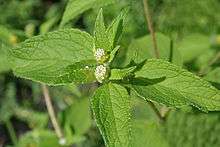Blainvillea
| Blainvillea | |
|---|---|
 | |
| Blainvillea acmella | |
| Scientific classification | |
| Kingdom: | Plantae |
| (unranked): | Angiosperms |
| (unranked): | Eudicots |
| (unranked): | Asterids |
| Order: | Asterales |
| Family: | Asteraceae |
| Genus: | Blainvillea Cass. |
| Type species | |
| Blainvillea rhomboidea Cass. | |
| Synonyms[1] | |
| |
Blainvillea is a genus of flowering plants in the aster family, Asteraceae.[2][3] They are native to tropical and subtropical regions of Africa, Australia, and Latin America.[1]
They are annual or perennial herbs. The flower heads contain small ray florets with toothed tips, usually yellow, or occasionally white.
- Species[1]
- Blainvillea amazonica - Loreto Region in Peru, Amazonas State in Brazil
- Blainvillea bahiensis - State of Bahia in Brazil
- Blainvillea dichotoma - French Guiana
- Blainvillea dubia - Queensland, Northern Territory
- Blainvillea gayana - Africa from Egypt to Gambia and KwaZulu-Natal; Yemen, Cape Verde
- Blainvillea lanceolata - Brazil
- Blainvillea rhomboidea - Brazil (Goiás, Minas Gerais, Pará, São Paulo, Sergipe)
- Blainvillea tampicana - Tamaulipas in Mexico
- Blainvillea tenuicaulis - Galápagos
- formerly included[1]
- Blainvillea acmella - Spilanthes acmella
References
This article is issued from Wikipedia - version of the 11/3/2016. The text is available under the Creative Commons Attribution/Share Alike but additional terms may apply for the media files.